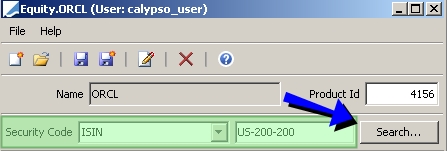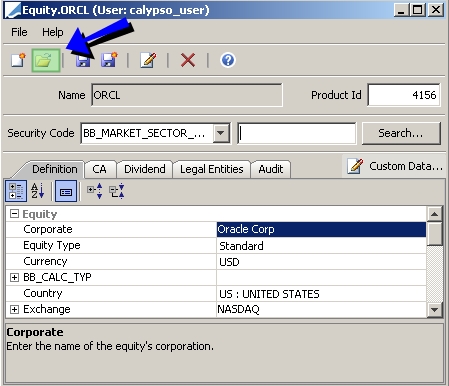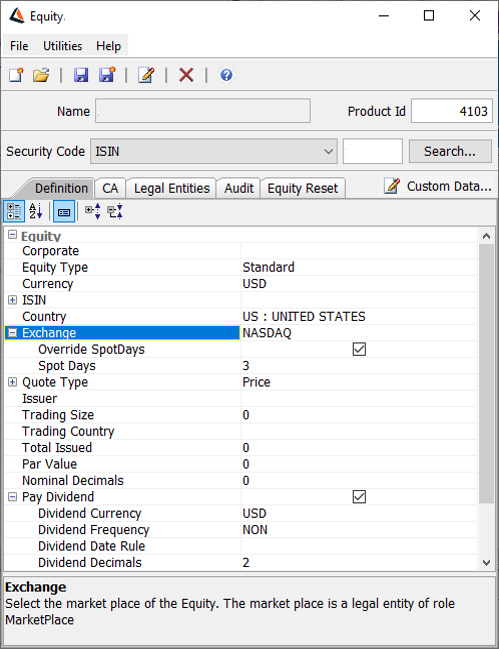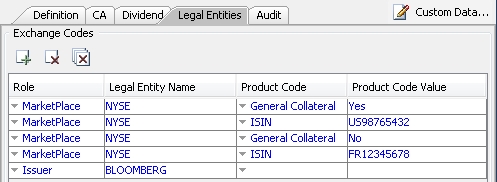Equity Product Definition
Prior to trading an equity, you need to create the Equity product. The equity product definition is required for equity and equity derivatives trading.
1. Defining an Equity
To define an equity product, from Calypso Navigator choose Configuration > Equity > Equity (menu action product.EquityWindow).
1.1 Loading an Existing Equity
You can load an existing equity into the Equity window using one of the following methods:
| » | Select a security code from the Security Code list, and enter the actual code value in the adjacent field. |
Then click Search to load the corresponding equity.

Equity window - Loading an equity by security code
| » | You can also click  at the top of the window to open the Product Chooser window - Help is available from that window. at the top of the window to open the Product Chooser window - Help is available from that window. |

Equity window - Loading an equity
Then modify the fields described below as needed.
1.2 Creating a New Equity
| » | Click  and enter the fields described below. and enter the fields described below. |
1.3 Modifying an Equity Name
| » | Click  to modify the equity’s name. You will be prompted to enter a new name. to modify the equity’s name. You will be prompted to enter a new name. |
1.4 Setting Custom Data
Ⓘ [NOTE: The Custom Data button is deprecated and has no function beginning in Release 12.0]
1.5 Saving an Equity
| » | Click  to save your changes. You will be prompted to enter an equity name. to save your changes. You will be prompted to enter an equity name. |
The system also saves a quote name for the product that is used to enter / retrieve market quotes.
You can also click  to save the equity as a new product. You will be prompted to enter a new name.
to save the equity as a new product. You will be prompted to enter a new name.
Definition Fields Details
| Fields | Description | |||||||||
|---|---|---|---|---|---|---|---|---|---|---|
|
Name |
Name of the equity specified when the equity is saved. |
|||||||||
|
Product Id |
Unique ID given by the system when the equity is saved. |
|||||||||
|
Corporate |
The long name of the corporate entity. |
|||||||||
|
Equity Type |
Select the product subtype. The subtype is for information purposes and can be used for filtering equities. |
|||||||||
|
Currency |
Select the currency of the equity. |
|||||||||
|
BB_CALC_TYP |
Expand this label to view all the security codes defined for equity products. You can enter a value for each security code as applicable. You can create new security codes using Calypso Navigator > Configuration > Product > Code. |
|||||||||
|
Country |
Select the country of the equity. |
|||||||||
|
Exchange |
Select the market place where the equity is traded. The market place is a legal entity of role MarketPlace. You can expand the Exchange to enter the Spot Days and also select Override Spot Days checkbox. |
|||||||||
|
Spot Days |
Default number of business days between the trade date and the settlement date. Business days are determined using the holiday calendars of the market place. |
|||||||||
|
Override Spot Days |
When this checkbox is unchecked, the value for spot days will directly come from legal entity attribute and it will be un-editable. However, if this checkbox is checked, the spot days field will be made editable and the user will be able to amend the spot days. The default value still come from legal entity attributes when the checkbox as unchecked. |
|||||||||
|
Quote Type |
Select the type of quote for the equity: Price, or PriceC (when the price is quoted in the number of cents). Ⓘ [NOTE: The PriceVol quote type does not apply to equities] Fixing Types The following fixing types are supported in addition to CLOSE, OPEN, HIGH, LOW, and LAST:
|
|||||||||
|
Issuer |
Select the issuer, a legal entity of role Issuer. |
|||||||||
|
Trading Size |
Enter the minimum number of equities that can be traded. |
|||||||||
|
Trading Country |
Select the country where the registry / depository is located. |
|||||||||
|
Total Issued |
Enter the number of equities that have been issued. |
|||||||||
|
Par Value |
Enter the par value as applicable, mostly for Asian markets. It is used to compute the withholding on stock dividends. | |||||||||
|
Nominal Decimals |
Enter the decimal places to use with the nominal. The default is zero decimal places. |
|||||||||
|
Pay Dividend |
Check the Pay Dividend checkbox if the equity pays a dividend. You can expand Pay Dividend and specify a dividend currency, dividend frequency, and the number of dividend decimals. The Dividend Frequency is used when creating a discrete dividend curve, to generate the projected dividends. The Dividend Date Rule is not currently used. |
|||||||||
|
Active From |
Enter the date when the equity is active for trading. |
|||||||||
|
Active To |
Enter the date when the equity is no longer active for trading. |
|||||||||
|
Status |
It mostly applies to Bloomberg static data integration, but you can use it for your own purposes. It shows the status of the integration. You can change it as applicable.
|
|||||||||
|
Comment |
Enter a free-form comment as applicable. |

2. Viewing Corporate Actions
The CA panel shows the corporate actions that have been created for the equity in the Corporate Actions window.
This is for information purposes only.

Equity window - CA panel
3. Specifying Dividends
Ⓘ [NOTE: The Dividend panel is not supported and must not be used to create dividends. The dividends must be created directly from the Corporate Actions window]
4. Defining Security Codes by Legal Entity
Select the Legal Entities panel to specify security codes by legal entity as applicable. A row is created by default for the issuer of the equity.

Equity window - Legal Entities panel
You can use this panel to specify for example specific product codes by market place.
| » | Click  to add a legal entity, then select a role, a legal entity, a security code (product code), and enter a product code value. Repeat as needed. to add a legal entity, then select a role, a legal entity, a security code (product code), and enter a product code value. Repeat as needed. |
| » | Click Save to save your changes. |
5. Viewing Audit Information
Select the Audit tab to view Audit information recorded for the equity. This only applies if the Audit mode is enabled.

Equity window - Audit panel
You can right-click the table and a number of functions will be available for configuring the layout.
6. Specifying Equity Resets
You can define multiple equity resets using the Equity Reset tab as needed. You can then select the actual equity reset to be used when you capture the trades.

By default, the system adds an equity reset for the Exchange specified in the Equity definition.
To add more equity resets, click ![]() and select a source and a type. You can modify the name as needed.
and select a source and a type. You can modify the name as needed.
If no default equity reset is specified, the trades will use the "CLOSE" equity reset which corresponds to the spot quote.
When using equity resets, you can set the fixing quotes for the quote name: "EquityReset.<equity name>.<reset name>".
For example: "EquityReset.GOOG.NASDAQ".
Make sure to save the Equity.